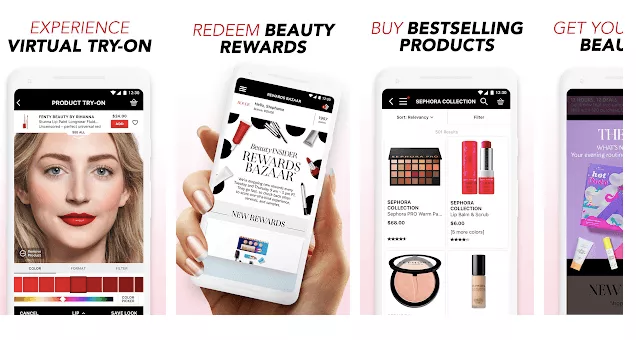Creating an excellent customer experience is the key to success in any eCommerce business. Historically, this involved appealing to our customers' five senses. They needed to see what they were buying, feel it, taste it, hear it and smell it before they would buy a product from a brand. This worked well because traditional retail was a tactile experience where all the customer's senses were stimulated by products on a store shelf or a display case.
But times have changed and retail is no longer limited to the physical world - today's consumers want more interaction from the company, including social media channels and website features that make them feel unique and valued as a customer.
Today, having an online store is not enough. Consumers are increasingly transitioning to the digital landscape for their shopping needs and expect a wholesome physical-like experience (yes, you can blame the metaverse for it).
But as an online store, how do you offer such an immersive experience?
In this blog post, we’ll examine 7 new eCommerce technologies that you need to watch out for in 2022 and that can help you turn your store into an unforgettable immersive shopping experience.
7 new technologies to transform your customer’s eCommerce experience
1. Omnichannel presence and support
Your customer’s experience from the moment they land on your site to the time they complete the checkout process needs to be seamless. In order to do this, it is crucial that you have a strong omni channel presence and support. This will ensure that every customer has the opportunity to buy from you no matter where they are or what device they use- laptop, tablet, or smartphone.
"Omnichannel'' means that your company has a website, an app, and physical locations in order to reach out to customers. The idea behind this is that people are shopping in locations other than the internet - whether they are using their phone while on the go, looking for something in a store, or trying to find your products in a magazine.
To have an effective omni channel presence, you need to have high-quality content on all of these channels.
For instance, Sephora prides itself on being one of the best omnichannel marketing retailers as they blend the online and in-store experiences seamlessly. When in-store, the brand provides a consistent experience with beauty tips, free makeovers, and product try-outs. However, when online, customers can use their Sephora accounts to track purchases and scan items while they are in the store. Creating this experience helped this beauty retailer gain a nearly 100% increase in mobile orders.

The concept of OMNI is not new, but it’s being taken to the next level. The idea is that omnichannel retail should take into account all channels that shoppers use to interact with a brand or retailer. This includes physical stores, phone orders, chatbots, and web-based self-service tools.
Another important aspect is customer service - businesses need to make sure they provide omnichannel support to their customers in order to keep them satisfied and coming back.
With the development of new technologies, it's now possible to offer customers real-time communication across channels.
For example, imagine if an issue came up with your customer's order, not only could you chat with them on Facebook messenger but also email them or call them on their phone. Plus, you could ask for reviews on Yelp or Google. With all these options available to you, you'll be able to keep in touch and engage with your customers no matter what!
2. Extensive personalization
A large number of brands are adopting personalization in their products or services to build brand loyalty. While consumers have a myriad of choices when it comes to selecting a brand, the brand that can provide them a personalized shopping experience can win them in the long haul. By offering more customization options, companies increase customer satisfaction and loyalty.
In the online space, personalization is everything. Personalized product recommendations are essential because depending on what they buy, people want to be treated differently.
Whether visitors are emailed or shown on a specific site based on their past history of purchases, showing them an individually tailored product selection will increase the likelihood that they will buy from you. With powerful technologies such as machine learning and voice-to-button conversational interview, your business can offer a customized experience for every customer.
One study revealed that when brands implement personalized experiences on their site or in their marketing efforts, it translates into a strong effect on revenue, and advanced personalization can even lift their revenue up by 25%.
When personalized product recommendations are made based on the consumer’s preferences and interests, a retailer can witness quantifiable business results from such recommendations.
A Shopify store, Good Cup Coffee increases conversions by 34% with product recommendations. They display their best sellers on the homepage, but also use frequently bought together recommendations to further cross-sell items, leading to higher average order values.

Product customization and personalization will continue to grow as one of the leading eCommerce technology trends. Without a doubt, personalization is paramount when it comes to providing the highest possible customer experience.
Consumers want an item they have in mind, and it’s up to you to show them they can actually get it! Investing in a CRM would give you the tools you need for this crucial step, with direct campaign management capability through email, web push notifications, or your mobile app.
3. Conversational commerce marketing
While traditional marketing channels usually flow in one direction, conversational marketing opens up various possibilities for eCommerce success by paving a path to two-way communication.
Conversation marketing can be defined as using social media to converse directly with your prospects and customers. This type of marketing is known to yield higher conversion rates because it elicits more trust, fostering a two-way conversation about the customer's challenges. Conversation marketing is also known for producing tangible results through interactions on social media.
Conversational marketing uses artificial intelligence to personalize the customer experience. It may sound far-fetched but cutting-edge technology like natural language programming can convert human speech into meaningful text that an AI agent can comprehend. These programs are able to look for specific clues in the words spoken, idioms, emoji, and emoticons to find their meaning which it then passes on to the customer.
Conversational marketing will change the way your business communicates with customers. You can use chatbots to locally sourced, real-time data from your databases to deliver a personalized customer experience.
For automation, companies are turning to chatbots. These artificial intelligence systems simulate human speech and are hands-free. They can even respond to your customer's emotions by sending emojis to make the conversation more personable.
Chatbots and online in-store sales associates play a major role in complementing the eCommerce sales process and bring customers closer. Customers can ask about anything from what material a piece is made of or about the measurements of a piece of clothing they are interested in. Tools like WhatsApp, on-site chatroom, and Facebook Messenger make it easier to do so.
For example, consumers buying from luxury brands like Louis Vuitton and Prada can leverage their on-site AI-powered chatbot to get quick answers to some of the questions related to purchasing, delivery, and returns. If the bot is unable to answer any extra questions, a “real-life” sales assistant steps in to help by sharing pictures of the products and expert tips.

Another tool used by companies to facilitate conversational marketing is messenger apps. Facebook Messenger and WhatsApp employ chatbots, making it easier to engage with customers 24/7.
Burberry has a virtual assistant named Lola on one of the most used messaging app in Europe. On the other hand, French brands Celine and Yves Saint Laurent actively connect with customers through mini-websites on WeChat, where they sell them products.
4. Shift to mobile (mCommerce)
Did you know that 56% of people use mobile devices to visit web pages? In 2021, mobile devices (excluding tablets) generated 54.4 percent of global website traffic and made up for 53.9% of all e-commerce sales. Moreover, the sales generated from M-commerce are projected to surpass $3.56 trillion in 2022
When it comes to eCommerce, Mobile commerce will soon surpass desktop for many stores. Mobile-based commerce is growing at such a rapid rate that’s never seen before with store owners expecting mCommerce to be the main channel for online shopping as almost 87% of shoppers engage in online product search before buying. With each passing day, the number of smartphone users is rising, amplifying the role of smartphones in e-commerce traffic, as customers are increasingly using smartphones for online shopping.
It may sound counterintuitive to suggest that eCommerce websites should be "mobile-friendly", but the end of physical stores means more and more people are doing their shopping online. If they can't find what they're looking for quickly on your site, it is likely they will go to a competitor's site where they will find the product.
This is why online store owners are placing a huge emphasis on creating a mobile-friendly site. With over 65% of people accessing eCommerce through mobile devices, the onus is on retailers to design their site for mobile shoppers.
Mobile presents an opportunity for smaller businesses to compete with the giants by offering relevant content, friendly navigation, and well-crafted functions that support key product features. Shoppers also expect fast load times on sites so you’ll need to step up your efforts if they’re to compete on speed with Amazon, which has 2 seconds average load time.
Mobile optimization directly influences your store’s online ranking on any search engine, with mobile friendliness being a prominent factor in the ranking algorithm. All the more reason to shift to become mobile-friendly.
Some brands on Shopify have been quick to catch up with the rising demand of mobile shopping. For instance, Bailey’s Blossoms has set up native mobile apps for both iOS and Android to make it easier for their existing customers and target segment to shop from them, on the go.

5. AI chatbots
The eCommerce world is evolving, and with that consumers are interested in more efficient and effective communication. And that's where live chat (and even chatbots) comes into play. One of the most exciting technologies is artificial intelligence chatbots, which will help replace email and instant messages with interactive communications. Accounts can be personalized with customer data such as name, location, purchase history, and more to improve the experience by communicating needs and answering questions.
A survey by Zendesk revealed that customer satisfaction ratings for live chat (85%) outpaced all other forms of communication, including email and social media (except phone support ). Live chat is designed to effectively guide a buyer throughout their customer journey. It helps with the following:
- Answer customer questions
- to increase conversion rate
- Engage customers to keep them on the site longer
- Provide post-sales customer support (such as how to use a product)
- Provide information in real-time
Without live chat messaging, visitors have no choice but to search your website for additional information or contact you via phone or email. And if they fail to find this information promptly, it may even chase the buyer away forever.
AI chatbots are a technology that is trying to make interactions with customers more human. A customer's chatbot will be designed to sound as much like a real person as possible. It will take the form of an avatar and may even use voice recognition software. The bots have certain algorithms that have been refined over time to detect simple language patterns for faster responses and solve repetitive queries faster than any human customer representative could ever do.
They also handle difficult issues without needing any outside intervention which means people are more likely to want to use them for long conversations where they might otherwise hang up.
Here’s how Spring is making use of chatbots for understanding consumer preferences and helping them find the right products:

Chatbots can deliver customer service 24/7 and allow retailers to communicate with thousands of their customers while giving them the feeling of personalized contact.
They are especially beneficial because they allow eCommerce companies to provide assistance without taking up company resources or time. The chatbots answer customer questions and complement the customer service professional. They also help the company build a stronger rapport with the customer by providing rapid customer service. The chatbots can even monitor order statuses and alerts, saving people from having to monitor their orders themselves and know when the package will arrive.
While chatbots today are mostly used to provide customer support, it's likely that they will become one of the most important marketing tools for a retailer. For instance, in the future, chatbots would behave like personal shopping assistants to help shoppers get what they want. They will record the purchase process in the form of data and use it to help anticipate new products that customers might like.
6. Image search
Image search in eCommerce is a must-have feature that simplifies the one common frustration for shoppers: not knowing what they need. Image search is the next generation of user-interface.
It’s a technology that uses AI to process what you see with your eyes, and then gives you options for what you might be looking for. With automated image search capabilities, customers can immediately shop for products by browsing actual images of the item that are highly relevant to them.

eCommerce businesses are nowadays integrating image search technology on their sites with a third party vendor so that customers can photograph products easily in which they are interested and come up with similar instances on other websites that may be providing better deals. It allows the customer to instantly see what's available on their eCommerce website without having to enter any kind of word or product query. Shopping results will show up as the camera is swiped over items.
Image search engines may be more accurate than voice searches. Because there is no need to transcribe, the engine can scan millions of images instantly and find the best match for what you are searching for. It can also suggest content based on your preferences and recommend related products that you might like.
With an increasing preference for voice and image-based searches when shopping online, customers are now able to organize their searches with much accuracy and fewer hassles. Furthermore, image-enabled services are much more engaging because now customers can photograph the products they’ve eyed for a long time and potentially find similar examples on other eCommerce sites from the comfort of their homes.
These types of searches give rise to a lot of eCommerce business opportunities through smart and solution-oriented services.
Target leverages image search by integrating Pinterest’s lens into their app so that people can take a photo of something they like and see if they can find it on the Target app. Using this strategy Target could increase its sales by almost 10%.

7. Efficient checkout process
One of the biggest issues faced by online retailers is cart abandonment with approximately 79% of shoppers abandoning their cart at the last minute. And guess what the biggest reason is? Inefficient checkout.
An inefficient process of checkout increases the chances of your users abandoning their cart, thereby losing you a big chunk of potential revenue. As a retailer, the last thing you want to do is disappoint your customers. That's why ensuring a smooth checkout process is crucial for boosting customer satisfaction and revenue results.
The process of buying things through the internet is always a hassle. People want to finish quickly and they can't allow any distraction to get in their way.
Numerous surveys have shown that people get frustrated with common checkout hassles such as standardized forms, forgotten passwords, and shipping charges. In order to improve the user experience, websites can use a variety of technological solutions including AI chatbots, QR codes, assisted checkouts, one-page checkouts, and fast mobile payments.
With these, customers don't need to fill in any personal information such as address or credit card details. They simply scan their fingerprints and then proceed to the next page that contains the button that sends them directly to an out-of-store payment device instead. The whole transaction will take less than 10 seconds, significantly speeding up the "painful" experience of online shopping!
We wrote a detailed post on how to optimize your checkout process for faster purchases across all devices: 15+ Shopify Cart and Checkout Best Practices for More Conversions.
Do you need to adopt technology?
All of these technologies have one goal in mind: to increase the level of engagement with the customer and provide them with a seamless experience from start to finish. With so many options available for both entrepreneurs and online stores, it’s never been easier to stand out in the crowd and be original in a given industry.
Innovative new technologies will help retailers create more compelling and immersive customer shopping experiences. Harnessing these cutting-edge tools can open up new avenues of growth for brands. If you’re an online store looking to gain that extra edge in a competitive market, get comfortable with these technologies and figure out how to make use of them for increased customer engagement and brand loyalty.
Before you decide which eCommerce technology trend to integrate on your store, study your audience and recognize their expectations from your brand. Observe how they typically interact with you and what different is your competition doing that’s giving them an added advantage. Finally assess the resources available to you and decide what will work the best for your storefront.
Which ecommerce technology trend are you most keen to adopt for your online business?
Want to explore the capabilities of Shopify as an eCommerce CMS to implement these technology trends?




